Having described my local patch and things I saw in March I shall attempt not to repeat myself too much so if some birds or animals do not get a mention it is not necessarily because they have not seen it but rather there is nothing new or interesting to record about them.
One morning whilst out walking along a bridle path in the Park a Long-tailed Tit lands on a bramble bush just beside me. The bird disappears into the tangle of bramble and shortly afterwards re-appears on the top of the bush. It flitters around before taking off and flying into a nearby tree. On closer inspection peering through the Bramble stems I can see an oval shape that is several feet off the ground, my first Long-tailed Tit nest! A real treat to find something that would usually be so well hidden by the time I am looking for it.
After the first week of April many more trees are turning green as their leaves break through and they prepare for their spring and summer growth. The light in the evening shines through the leaves and the newly opened, green leaves look like miniature lanterns for a few minutes when the sunlight hits them and it would appear the whole Park is beginning to turn from brown to green. There are even seasonal ponds in places I have only noticed the rushes and dried mud before, the heavy, persistent rain of winter lingers in these places and although patches of the sandy soil are dry and bare, in part there are still mud and wet patches. They will be dry soon enough as summer comes.
The bright yellow flowers of Lesser Celandine decorate some of the open patches within the Park, especially along the wall path that leads from Kingston to Ham Gate where they are pretty common. The walk up the hill from Ham Gate towards Isabella Plantation yields another flower, one of which I have never really noticed in the Park before, Common Dog-Violet (Viola riviniana), the species with the pale spur. There are a few decent sized patches partially hidden under Brambles and a few flowers that seem to be on their own and out in the open. On the other side of the road towards the pond on the hill there are even more Dog-Violets in the open along with a pair of Egyptian Geese also on the edge of the pond. Blue Periwinkle flowers are visible behind the fence in Isabella Plantation and a couple of the Hawthorn trees there are also coming into flower, a white and pink mass on the trees. Bluebells do not appear to be out on 7th April but the stouter and more robust looking Spanish Bluebells are certainly appearing in the gardens which are around the edge of the Park.
After the exciting bird life seen in March all appears to have settled into a pattern and the same species are seen and heard once more. It will soon be time for the migrants I hope, hopefully a flycatcher or two as I have not seen these in the Park although they are recorded. The Blackbirds are spotted gathering food so maybe their young are hatching but I can’t be sure of that.
At night and outside my flat the female Fox is making her strange, screams during the hours of darkness trying to attract a mate. Foxes are not uncommon around here and I have even seen on crossing the road on Kingston Hill. They are not afraid of people and are regularly visible in the early evening.

And now into the second week of the month some time is spent going around the garden on a warm, sunny, Easter Sunday. In the morning and from the balcony a Blackbird is seen with a beak full of worms and other food for their young. The only other bird is a rather upright and alert looking Magpie. After lunch and a not too promising start with just a few Bluebells (not the Spanish species but the white anthered UK one) in flower and a few other plants also in flower including a few Blue Alkanet, one dandelion and several patches of daisies in the back of the flats things improve. A few hoverflies are flying around along with some other flies including Green and Bluebottles and several solitary bees as well a buff tailed Bumblebee searching for a nest. A couple of the long snouted bee-flies (Bombylius major), always harbingers of spring in my mind, are seen flying low to the ground, looking for their host’s nests no doubt.
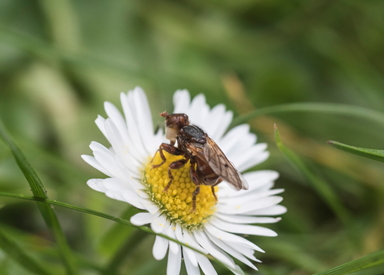
One interesting fly and one I have certainly never come across before is feeding, or perhaps resting, on a daisy and allows a close approach. It is identified as a Conopid fly, a Plain-winged Spring Beegrabber (Myopa testacea) and these flies parasitise bees. I have rarely seen these flies in the UK so am delighted to have one in the garden. Not so exciting to record is there is a Maple tree in the corner coming into flower and the Holly tree by the fencing has small, flower buds appearing.
The front garden is even more productive than the back and there are hoverflies mainly Eristalis sp again, at least three Holly Blues, a Small White in the back garden along with several species of solitary bee and at least a dozen Cuckoo Bees (Nomada species) are flying close to the ground, investigating holes and only occasionally coming to rest for a few moments before continuing their search for mates or solitary bee nests so they could lay their eggs. I spend sometime trying to photograph them, well it keeps me amused and passes some of the lockdown time and all on my own property! I think it is therefore time to move from the telephoto photography to the macro for the time being.
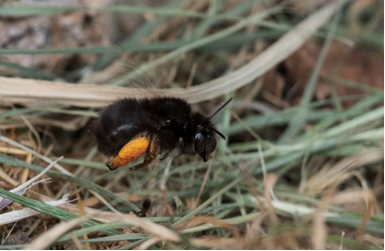
Along the edge of the earth bank that goes up to the garages at the front of the building, there are a number of holes in the ground, probably about 40 or so which are 5-8mm in diameter, the nests of another solitary bee, a largish, mainly black mining bee with a yellow leg which is Anthophora plumipes.
Later in the afternoon the sun is getting lower in the sky and bees and bee-flies are resting before the place goes into shadow but a solitary bee with a bright red-orange thorax scuttles into the grass and no doubt its nesting hole. It must have been Andrena haemorrhoa which has this typical and distinctive colouration and just before I give up for the day a Kestrel perches for about 30 seconds on the roof of the flats before flying off, another highlight of a garden day.
A second day on garden insect safari is as good as the first with lots of insects being seen and photographed. Hoverflies include small, medium and larger ones and bees whilst not as numerous are also present. Nothing special like the Conopid fly but bee-flies are common as are the Nomada bees, perhaps more numerous than on the first safari and like the Nomada bees bee-flies tend to parasitise the nests of the Andrena mining bees. The hoverflies include a single Marmalade Hoverfly, a male Eristalis pertinax patrolling and settling on a small tree, Myathropa florea, Epoedes latifasciatus, Platycheirus sp, Helophilus pendulus and Epistrophe eligans. Other bees pose nicely so should be identifiable at least to genus level, two hours well spent. Unfortunately much of the insect activity is high up in the trees and bushes so the animals themselves are too far away for photography.
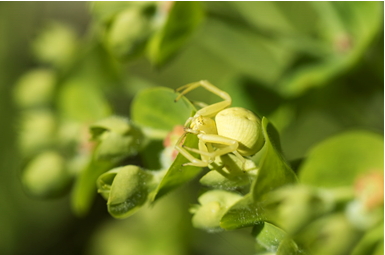
Over the next few days the number of species does not appear to rise but a new creature here and there add to the enjoyment whilst my daily walks in the Park are becoming more for exercise than finding wildlife. The sunny, warm weather has kept the invertebrate numbers up but on the Thursday when the temperate cools down many disappear from view. The Oak trees are all coming in to full leaf and the other tree species are following hiding many of the birds from view although the quietness of the Park allows you to hear them much more clearly than normal. The commoner birds are still there, the Parakeets but Robins pop in and out of bushes hiding quickly along with most of the smaller birds. No obvious migrants are around but they should start appearing soon. I miss the call of the cuckoo which I should be hearing in the Lea Valley and Blue House Farm but it has to be and so the most exciting new find of the 15th and 16th April is of the yellow form of the Crab Spider, Misumena vatia found on a Spurge bush in the garden. Not only one is found but two of these amazing animals are perched on Spurge flowers, bright, lemon yellow and one is in the hunting gait with its legs outstretched waiting to grab any insect fool enough to come to close to it.
Whilst walking to the pharmacy and back I see more birds on the pavements of Kingston than ever before, there are at least three Robins searching for food and a Blackbird, all of which would normally fly off way before you get close enough to have a good look at them but these birds are reclaiming the streets and stand their ground allowing a closer approach than normal before they fly away.
Week three of the month, 21st April and the bee-flies seem to have finally gone, none are found today although there have been one or two over the past few days. The hoverflies are still enjoying the sunny but windy weather and the most obvious are the Batman Hoverfly (Myathropa florea) which appear to be bigger than most so dominant the others by their size and aggressiveness when defending a sunny spot they like. There are less Epistrophe eligans around and they tend to rest lower than other hoverflies, often less than a foot off the ground. The small Platycheirus species are still around, a black one with grey spots one hangs around the same bush as before and a yellow and black one appears for a few seconds on the Holly bush. The flowers of this and the Elder are in bud and should be in full flower within a week I hope. They should be good for insects if the wind drops! However that proves a false hope…
Bees are around, solitary Andrena sp and no doubt a few others that I am missing and the Nomada bees are still flying around either low to the ground investigating holes in the ground or higher and along the edge of a privet hedge where they settle for only a few seconds before taking off again. Never seen so many before and it makes me wish I had spent more time investigating my own garden in previous years…
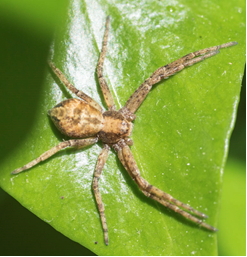
A surprising insect today is a Large Red Damselfly. I did not know there were any sites they could breed nearby so I am guessing there must be ponds around in some of the local gardens. The two Misumena vatia spiders are still in the same places on the Spurge and one had a fly yesterday and the other has one today so they are catching prey which given their apparent lethargy surprises me. It would be lovely to see it actually happen but think that is most unlikely. There are a couple of other crab-spiders (different species) on the trees and bushes and they need further investigation for sure but one was certainly a Xysticus species. Another interesting few hours spent in the sunshine and breezy conditions. Maybe tomorrow the wind will be less breezy so I can get some sharper invertebrate shots!
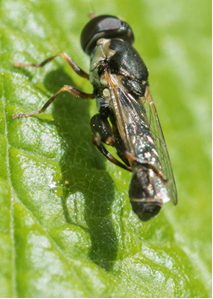
Overnight the numbers of Nomada bees seems to have dropped a little despite it being another warm, sunny day. There are hoverflies around and the only new one is the small, grey and black but distinctive Syritta pipiens, it has a very inflated hind thigh which means it is an easy species to identify as was the first male Orange-tip butterfly of the season that flies by. A Peacock butterfly also flies across the garden, the Holly Blues fly around the Holly tree and a Small White goes by too. Nothing amazing but better than nothing. My walk through the Park round about lunch time is not very productive, a woodpecker is heard, birds are singing although unidentified and Coots are nesting on the pond by Ham Gate. Hoverflies are around but not settling and the Lesser Celandine is still in flower.
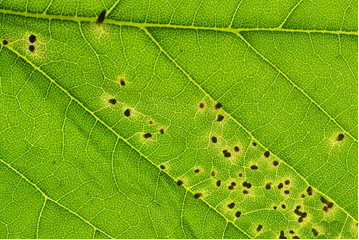
Another hot day in the low 20s and the insects appear to be disappearing or hiding away under leafs to shelter from the heat. In one patch or bushes and trees just to the left of the entrance of the block of flats all of the insects seem to have disappeared bar one or two so rather than the dozens of there were a few days ago there are hardly any around at all. Mainly seeing the same species as before but a nice hoverfly addition is the long rostrumed Rhinga species, which from the poor photographs (windy again…) appears to be R.rostrata rather than R.campestris (shorter rostrum = “nose” and no black markings on the abdomen). Holly Blues are abundant and small insects around the Horse-Chestnut and Yew trees appear to be lekking. These appear to be gall wasps on closer inspection although they are proving difficult to photograph as they are constantly on the move. There are red galls on the Sycamore leaves but these are caused by Aceria mites and not the flying wasps. The two Misumena vatia spiders are in exactly the same spot on the Spurge for the fourth day in a row!
Birdwise nothing new to add, the Magpies own the garden and a Robin sings from the Holly Tree but not much else is visible apart from the occasional view of a Blackbird and the Jays flittering around as they go through the garden but there is nothing else to mention.
For once my afternoon exercise walk in the Park proves interesting, things have been getting a bit dull recently. A scattering of flowering Bluebells are seen around Ladderstile Gate and along the path heading down towards Kingston gate. Nettles are almost two feet high and the Bracken stems are starting to unfurl their fronds, creating an almost a planted field like effect in the woodland close to Kingston Gate. Yellow Dandelions are in flower and in some patches they are also in seed but no other plants are flowering. I notice that some garden trees are in flower on the walk up to Ladderstile Gate and some smell, not too pleasant to me, although others may like their scent. Birds are not much in evidence other than the ubiquitous Jackdaws although at least three maybe four Greater Spotted Woodpeckers are heard, their short feeding “drumming” call, and in the Oak trees there is a bird song I do not recognise. I look up into the tree and beautifully lit there is a Song Thrush, delightful and a nice end to a quick stroll through the Park.
April 25th is a bit colder than the rest of the week but the garden hoverfly list continues to grow with the addition of Syrphus vitripennis and a Dasysyrphus sp (almost impossible to speciate the females of this genus and this one was laying eggs on a plant near to a small aphid colony). The Large Red Damselfly still patrols the same part of the garden as do several other of the insects and a single Bee-fly makes an appearance today along with a couple of Bumble Bee queens searching for nesting sites. Looking at the photos there are probably three or four species of Andrena species but actually speciating them is another story! If that is the case then it is possible that there are several Nomada species around too (which the photos do prove to be the case when I get to look at them closely). A single Garlic Mustard plant is in flower along with the two Horse-Chestnut trees in the garden but not much else.
A Sunday morning walk in Richmond Park isn’t particularly fruitful in photographic terms but there are Horse-Chestnut Trees in flower along with Hawthorns and flying around these trees in most cases are swarms of St. Mark’s fly, with their typical dangling legs and looking very black. On a Bramble there is a single Green-veined White butterfly and a bit further along a couple of Speckled Wood butterflies are fighting over a sunny spot. A couple of Peacock butterflies are resting on the ground and one of them is seen perching on a bare tree trunk. There are other insects around but it is hard to get close to any of them. There are many Bluebells coming into flower, the native form rather than the imported Spanish one, and their scent is strong at one point where a small carpet has formed in Isabella Plantation, a shame it is still closed. There is a clump of flowering Garlic Mustard on the edge of Isabella Plantation but not much else. Again birds can be seen but only Jackdaws and Parakeets are obvious with the exception of a single Dunnock that is singing from the top of a bramble bush. Back home there is nothing new in the garden except for two Peacocks flying around the garden at round about 17:15. Wonderful to have two together, probably courting, although unfortunately when they get together the one on top one turns out to be rather tatty as I guess can be expected from an overwintering species that has been on wing for more than a month. Shame but still good to see nonetheless.
The last few days of the month produce wind, rain and a chill in the air so I do not bother trying to find any insects or even take the camera out!
 Leave a comment about this comment
Leave a comment about this comment